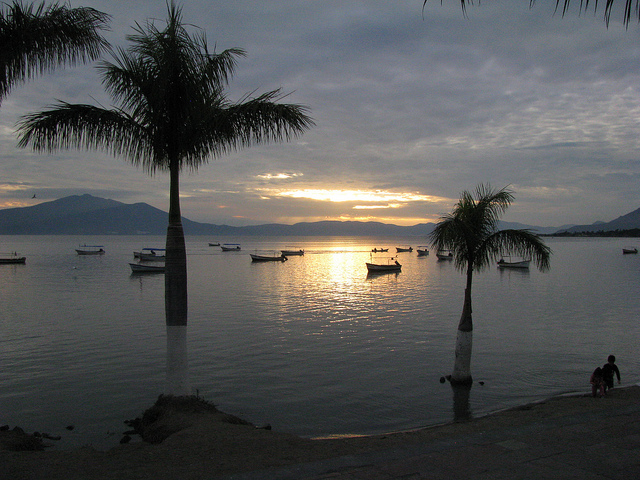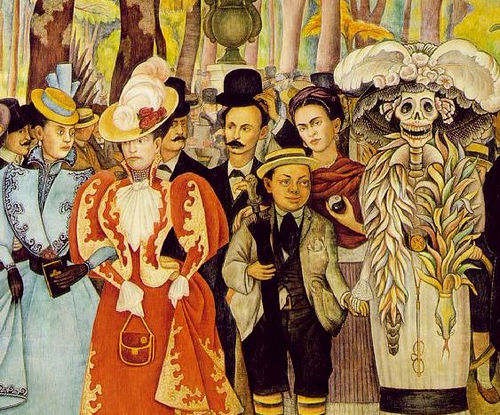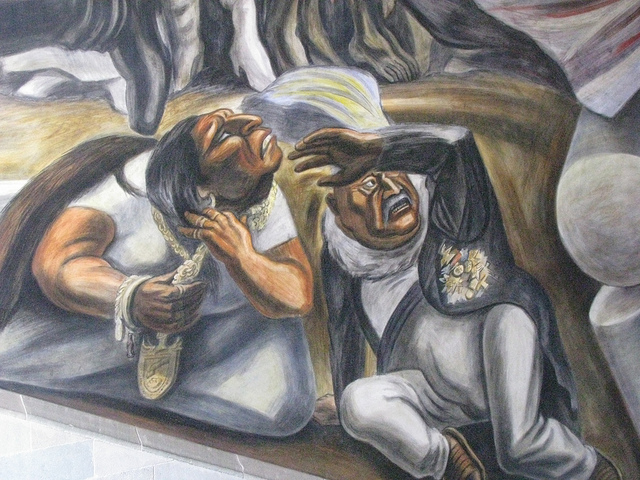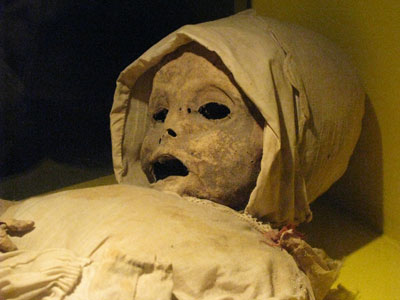To get to know the city better, I decided to join one of the double-decker sightseeing tours called Tapatío Tours. “Tapatío” is incidentally a nickname for a person from Guadalajara. The red buses were stationed in an attractive park called the “Rotunda de Los Hombres Ilustres” which features a mausoleum of important personalities from the state of Jalisco right next to the cathedral. I managed to score a seat upstairs right in front of the bus, and to the right of me was a retired couple from New Orleans. The older gentleman started a conversation with me and indicated that he has been living for about one and a half years now in the Lake Chapala region, a popular retirement destination for Americans and Canadians which is less than an hour south of Guadalajara.

Views from the sightseeing bus
This was an area I was planning to visit myself this week so I paid close attention to what he was telling me. In his thick southern accent he told me that he loved living in Mexico. He described the Lake Chapala region as safe and beautiful and even raved about the local Mexican healthcare, which costs him only $325 a year. His hobbies in his retirement paradise include line dancing as well as dancing classes to learn cumbia and salsa. As the bus started moving, he added that he would never go back to the United States; this statement told me how much he was enjoying his retirement in Mexico.

Guadalajara’s Glorieta Minerva from the bus
After spending about a half an hour in very dense traffic in the city’s centre, we finally started moving towards the suburbs of Guadalajara. We passed by the Glorieta Minerva, a roundabout that is adorned by a statue of the Roman goddess Minerva. The fountain has a diameter of 74 metres and is highlighted by the slogan “Justice, wisdom and strength guard this loyal city”. The statue itself measures 8 metres from head to toe and looks straight westwards.

Here are the imposing Millenium Arches
The next major sight on our bus ride were the Arcos del Milenio (the Arches of the 3rd Millenium), an impressive architectural monument consisting of six monumental arches of yellow metal that reach 52 metres at their highest peak. 1,500 tons of steel went into the construction of this monument and were intended to herald the beginning of the third millennium. However, the last portions of the project took until 2005 to be completed due to recurring problems with financing.

The Corona factory
Our double-decker bus also took us by the Corona factory, which produces Mexican’s best-selling beer and one of the most popular beer brands in the world. Now we were on our way back to the city’s centre and caught up with traffic again. At one of the intersections, a brightly costumed clown pulled up a step ladder and provided an impromptu performance in return for a few coins that were tossed to him by some of the motorists.

A clown does brisk business at a Guadalajara intersection
Closer to downtown we saw the Monumento de los Niños Héroes, a 50 metre high monument that celebrates the contribution of the Child Heroes, the boy soldiers who died defending Mexico City’s Chapultepec Castle against invading US forces during the Mexican-American War in 1847.

The Monumento de los Niños Héroes
After this hour and a half long sightseeing tour we had now returned to our parking spot just north of the cathedral and I had gotten a better overview of some of the important sights in the more outlying areas of Guadalajara. Now it was time to explore the centre of the city in more detail. Immediately east of the cathedral is a large public square, the Plaza de la Liberación, which is surrounded by a collection of historic buildings that include the Palacio de Gobierno, the Museo Regional de Guadalajara and the Teatro Degollado.

Downtown Guadalajara also has modern architecture
The Museo Regional de Guadalajara is housed in a former 18th century seminary and features displays on palaeontology, prehistory, archeology, ethnography and local history. Baroque architecture is represented at the Palacio de Gobierno, which is home to the state government of Jalisco. One of the main features of this building are murals by José Clemente Orozco that adorn the staircase, the upstairs congress chambers and the dome of the former chapel. This was the place where, in 1810, Independence hero Miguel Hidalgo proclaimed the abolition of slavery in Mexico.

The Teatro Degollado
At the eastern end of the square is the Teatro Degollado, built in a neo-classical style and opened in 1866. Nine massive Corinthian columns front the entrance, capped by a triangular pediment depicting Apollo and the nine Muses. A pedestrian zone extends for nine city blocks east of the square along the Avenida Morelos. I walked past a mix of historical buildings and square concrete blocks from the 1960s or 1970s. The street was lined by many souvenir shops, fast food outlets, clothing, shoe and jewellery stores.

Walking in the pedestrian zone of Guadalajara
At the eastern end of the pedestrian zone is the Instituto Cultural Cabañas, a former hospice that was founded in 1791 and fully completed in 1829. With its huge central dome and 23 courtyards, it is the largest colonial building in the Americas and one of Mexico’s finest neoclassical structures. For a long time the building was used as an orphanage and housed up to 3,000 children at times. From 1979 onwards it was restored and has since become an exhibition space and a designated UNESCO World Heritage Site. It also houses a phenomenal collection of murals by José Clemente Orozco.

The Hospicio Cabañas – a UNESCO World Heritage Site
After my walk back through the pedestrian zone I arrived back at the Plaza de la Liberación and decided to explore the district west of the Cathedral. This area was bustling with locals doing their shopping and eating at various street eateries. Now that it was the late afternoon, I was getting rather hungry at this stage and started to look for a nice-looking sit-down restaurant. Most of the places in the immediate area were of the fast-food kind, so I strolled back towards the cathedral and ended up on the Plaza Guadalajara, a large public square, facing the western façade of the Cathedral.

The Plaza de Armas in Guadalajara
The local tourist information had a booth on this plaza and I asked the tourist guide for ideas for a nice sit-down restaurant. She pointed me towards an attractive restaurant called La Antigua at the southern end of the square, just opposite the cathedral. I went upstairs and found a nice table next to a large window with a French balcony from where I had a gorgeous view of the cathedral. I ordered a “sopa azteca”, one of my favourite Mexican dishes. A thick tomato-based soup with tortilla strips arrived accompanied by little plates with minced onions, cubed cheese, sour cream, and guacamole.

Sopa azteca, my favourite Mexican soup
After a long day of studies and sightseeing, I sat back, enjoyed my soup and watched the cathedral as it was illuminated by large floodlights. The sun was setting in Guadalajara and I finished my leisurely meal before I took the bus back to Tlaquepaque. I had spent a long and full day studying Spanish and exploring downtown Guadalajara.

The Cathedral of Guadalajara – all lit up




